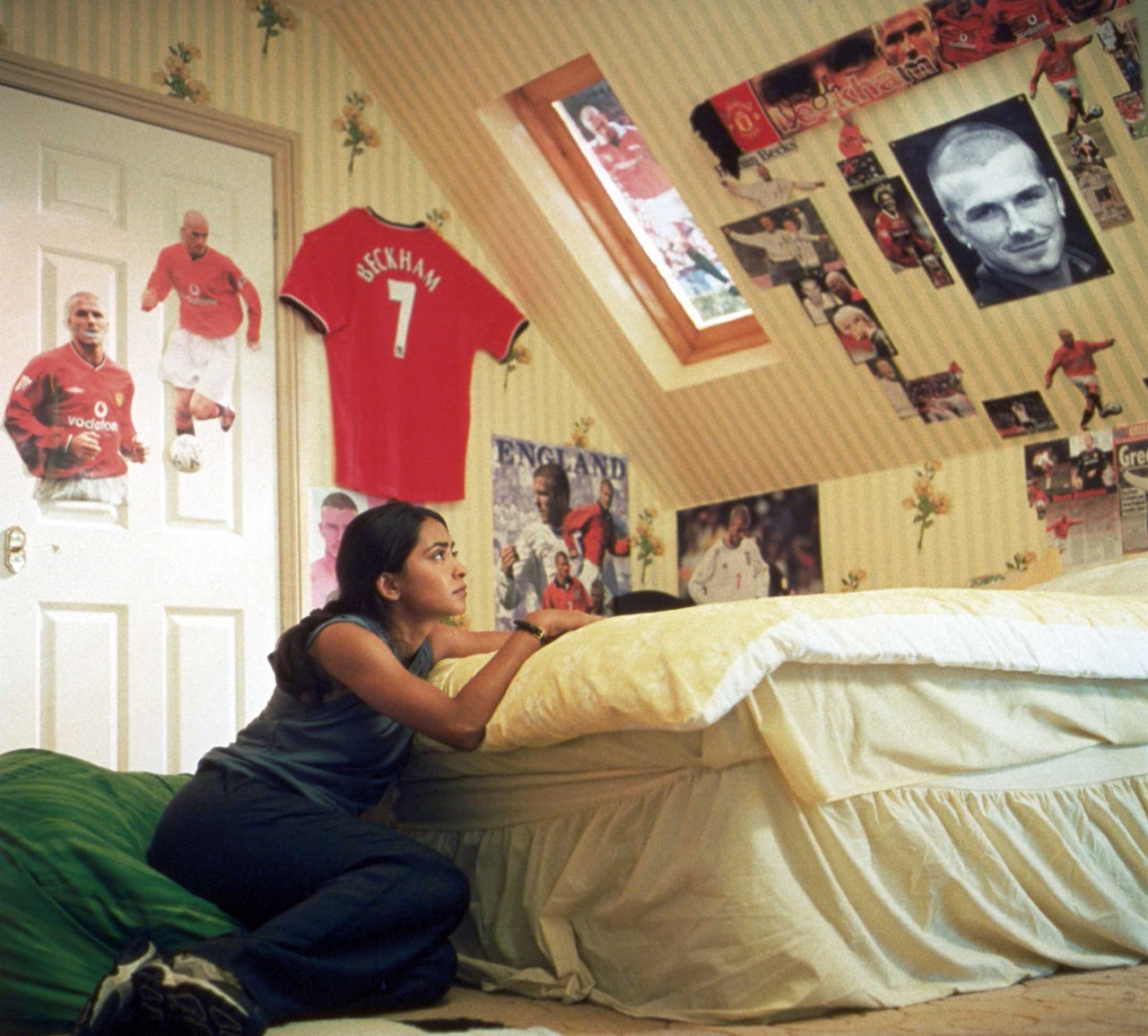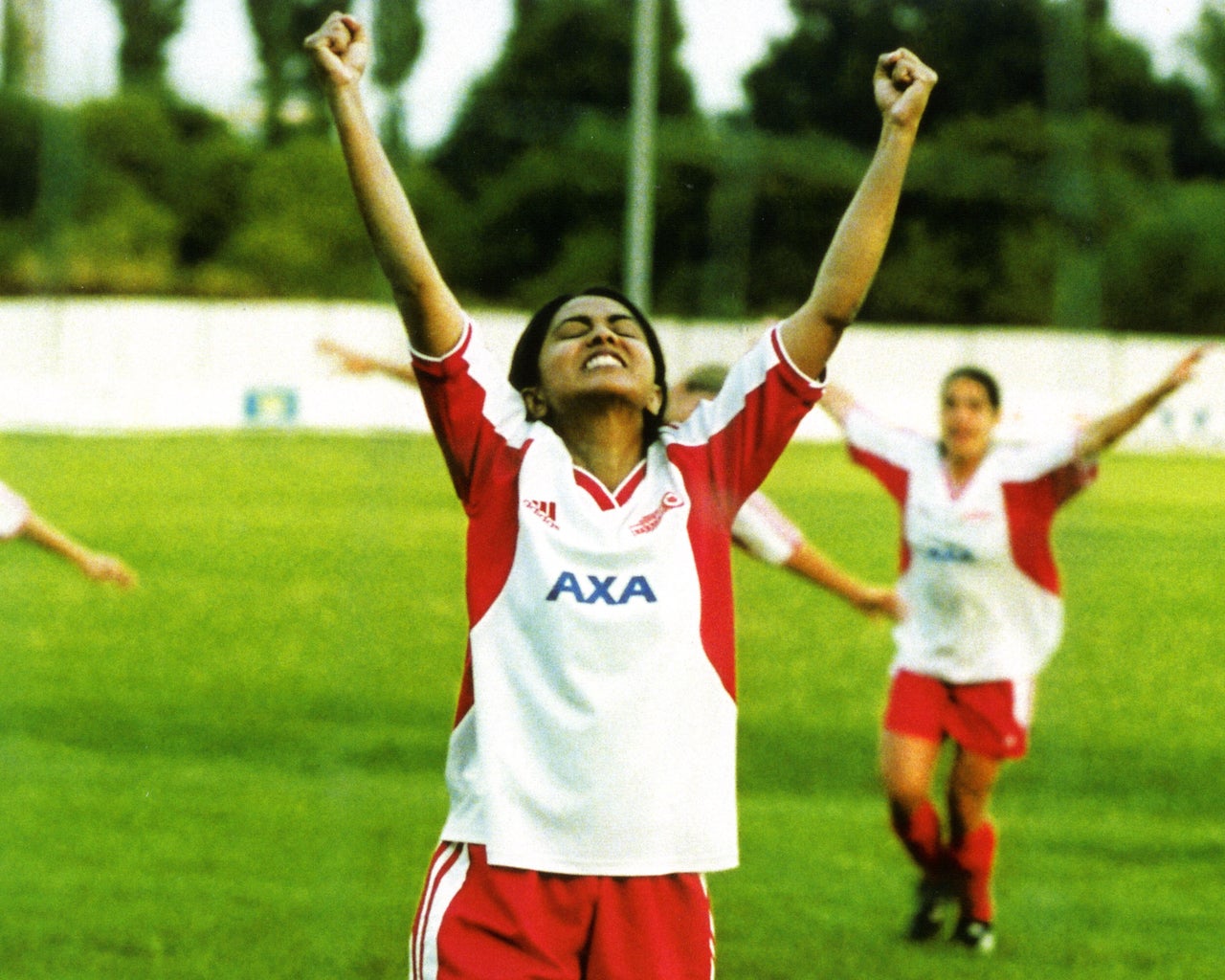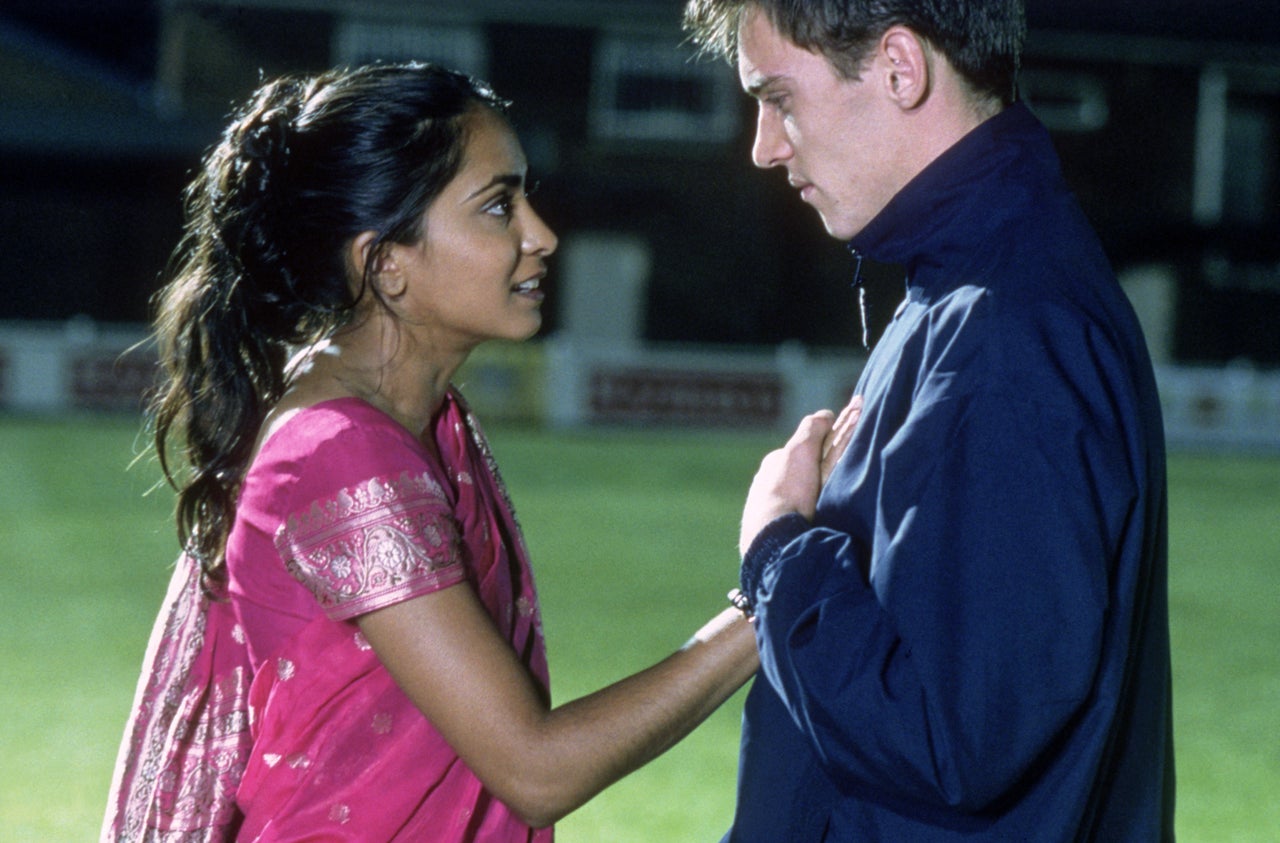In “Bend It Like Beckham,” Mr. Bhamra (Anupam Kher) makes a powerful statement to a room full of British Punjabi relatives right after his daughter Jess (Parminder Nagra) says she wants to go to the U.S. to train for soccer: “I want her to win.”
I still remember seeing my father, sitting in our Calcutta living room, tear up watching this moment. When the film, directed by Gurinder Chadha, was released in 2002, Hindi films fed us a very different idea of father figures — angry, rigid and just generally apathetic to the personal freedoms of the women in their family. Twenty years later, the film’s biggest legacy is that it didn’t teach us to be better daughters — but it taught parents to be better parents.
In “Bend It Like Beckham,” Jess is the soccer-obsessed Punjabi daughter of immigrants growing up in Southall who joins a women’s soccer team. Her parents would rather have her pursue higher studies and pick up domestic skills on the side. While she often sneaks away to play matches, things come to a head when she is spotted by a talent scout and is awarded a fellowship to train in the U.S., on the very day her older sister is getting married. The film helped change the way the world spoke of South Asian immigrants, viewed diasporic cinema, and the way in which films approached gender and sports.
There had been films — mostly of the indie, arthouse, festival-touring type — that had explored the “never the twain shall meet” lives of diasporic South Asians in Britain. In fact, Chadha made the criminally underseen “Bhaji on the Beach” in 1994. But “Bend It Like Beckham” was a watershed moment within British culture because it took British Asians to the mainstream, outside of the limits of exclusive film festivals and word-of-mouth recommendations.
For British South Asians like Syima Aslam, director and founder of the Bradford Literature Festival, who was in college when she watched the film, it was the creation of a unique visual culture that was moving away from Bollywood — which she enjoyed but didn’t quite identify with — and the social tropes of arranged marriage, conservative parenting and a general lack of agency for women that were prevalent around South Asian immigrants in the U.K.
“When I saw it, I went, ‘This is us. This is our life. This is how we live.’ South Asian and British,” Aslam said. The film was as British as the soccer-loving, Beckham-worshiping Jess, and as Punjabi as the Gurudwara-going, aloo-gobi-eating Jess.

For a film made by a British Punjabi woman about a family like her own, it is natural that “Bend It Like Beckham” holds up several mirrors for people who had shared Chadha’s journey and worlds.
My friend Uttara Gupta, who now works as a management professional, and I were growing up in India as two “darker-than-usual” girls just stepping into our teens when we watched the film in theaters. “I didn’t really watch too many films in English because those worlds were too far removed from mine,” she told me in a text message, “But when I watched this one, there was Jess who was dark, someone who looked like me, attracting the very cute Jonathan Rhys Meyers, who I went on to have a big crush on!”
For women outside of the U.K., the film was opening up other doors, into worlds where we could see ourselves as the heroine Jess who ends up with the white man, someone we had only seen falling for thin white women in films before. Unaware then of the dangers of defining our self-worth through the acceptance of a larger, white society, our fluttering teenage hearts felt validated.
But it wasn’t just about race and desirability; “Bend It Like Beckham,” like very few other films, was opening up conversations on ambition and desire in women across the world — beyond the U.K. and India. Alexandra Granda Baertl, who grew up a soccer fanatic in Peru and eventually made a career in sports management, watched the film on TV just around the time when women’s soccer teams were beginning to gain some visibility in her country.
“Soccer was a ‘boys’ thing’ and I really had to fight to play it, watch it, obsess over it,” she said.
For her, it was a very different kind of validation from Uttara’s and mine — the film showed her that it was OK for her to like soccer. It taught her when people don’t accept you for who you are, you have to fight for what you love. She came to know that there were girls in other parts of the world who were fighting this same fight to do something as joyful and as basic as playing soccer.
“It also made me so happy to see a girl like me — a ‘tomboy,’ if you will — was egging us on to just go ahead and play soccer. Because no one else was,” said Maria Fe Martinez, one of Baertl’s childhood friends.
Author and filmmaker Asha Dahya grew up in a South Asian family, with a father who was born in the Kenyan town of Machakos who then immigrated to the U.K., where she was born, and then to Australia, where she grew up. For immigrants like her, the film was a “trifecta” of nostalgia and belonging.
“I was in high school watching this film in Australia, and at once feeling a connection to British culture, to football and Manchester United, and to my diasporic Indian roots,” she said.
For a young woman, this is a complex (and often painful) longing that was being expressed in a very joyful story where the characters could be as loud and as colorful as they wanted to be. “I saw a woman directing it and wondered, ‘Could I perhaps tell my stories too, someday?’” she said.
Dahya is now finishing work on a short documentary on reproductive rights, and sits on the board of the Religious Coalition For Reproductive Choice.

Filmmaker Bhavani Rao, the founder of South Asian Women in Entertainment, grew up in New York with parents who had immigrated from India. “For me, that film is about my father. When he watched it, he saw himself,” Rao said. When she chose a career in film, Rao’s father didn’t quite comprehend her decision, but was satisfied knowing she was doing something that made her happy — just like Jess’ father.
For Rao, who had worked as a production assistant on “American Desi” (2001) — one of the first South Asian American films — the father-daughter relationship is the crux of the film.
“We had seen interracial love stories before, we had seen diasporic stories, and Chadha includes all of those themes, of course, but she focuses on the familial love, the tenderness,” Rao said, “something that not too many films showed in Brown families.”
As a South Asian woman working in TV, Rao is carrying forward a professional legacy that rests on the shoulders of filmmakers like Chadha. She recounted a South Asian Women In Entertainment event where the filmmaker addressed an audience of South Asian women working in film: “We all cheered her on and she said, ‘All right, let me take a video of this room.’ Rooms like that don’t come by often, and we were all in the room because of women like her!”
Today, “Bend It Like Beckham” is a political film. For Anisha Gupta Müller, a biracial, queer fitness instructor and gender activist in Berlin, who grew up in Oxford and watched the film in school. “It was [back then] a fun film about people of color doing their thing,” Müller said. Today, she realizes that Chadha made a film that was not exclusively about racism and pain, before representation and diversity became things in DEI corporate strategies.
“It was serving ‘clash’ of cultures, which is really the heart of my own upbringing,” she said. “I was seeing aspects of myself represented without even noticing it. That is what representation should look like.”
Filmmaker Pulkit Datta, who spent his teenage years in London and watched the film in high school, found echoes of Jess’ double life in his sister’s life. He also makes a point about the very nuanced portrayals of South Asian masculinity in the film. Jess’ best friend, Tony (Ameet Chana), is gay but is portrayed without any of the cringy femininity and the extravagance with which South Asian cinema — especially Bollywood — still perceives and portrays homosexuality.

There is another scene where Jess’ sister, Pinky (Archie Punjabi), makes the case for marrying a South Asian man, saying they now share household responsibilities and help out their wives. Traditional gender roles were changing in the diaspora, and Chadha was presenting a redressal of the ways visual cultures in the West (and “back home” in India) perceived South Asian masculinities.
Like any cultural product, “Bend It Like Beckham” opens itself up to the test of time and many retrospective critiques. My friend Uttara would never touch aloo gobi because of the traditional gender roles of cooking and feeding the potato and cabbage curry represented in the film. Today, it’s hard to look past the film’s now often-memed “Jess, I’m Irish. Of course I understand” line Jess’ love interest and coach, Joe (Jonathan Rhys Meyers) says to display racial empathy.
Jonathan Tranter, a writer and a software developer who grew up as a transracial adoptee in the U.K., brings up the inherent false equivalence: “Sitting in 2022, I worry it feeds into an idea of white innocence,” Tranter said. “The white-skinned Irish being racialized as ‘nonwhite’ brought in some solidarity here in the living cultural memory of people, but I doubt a shared history of marginalization brings in an automatic solidarity between white and nonwhite folks.”
But in its time, “Bend It Like Beckham” held space for people who were straddling cultures with a lot of pain and yet weren’t finding representation on-screen that did their emotional labor any justice.
“The film looked out from the inside. I run a literature festival so it’s easy to flatten things, lose sight of nuances. I try to bring as many people in on the inside, while we look out into the world,” Aslam said, looking back at how the film helped her cultivate inclusive spaces. “That’s how Chadha made the film and that’s how you make sure there are no wrong nuances.”
These spaces, though, have unfortunately changed a lot since the film’s release. Film editor Fahd Ahmed, who is of South Asian descent, went to secondary school in East London and watched the film when he was 15, on the last day of school before summer. His school was so diverse that white British students were a minority among the school’s 2,000 students. Muslim, Hindu and Sikh South Asians were the majority.
Ahmed highlights Britain’s changing cultural landscape and how a film made only 20 years ago has become somewhat of a nostalgic relic.
“Growing older, I’ve experienced ‘otherness’ on a daily basis,” Ahmed said. “The film was important for the potential and capacity of integration it represented but now, looking back, and with two decades of life experience, it exists in a space of nostalgia and some sorrow. I think back to it and remember the careless summer days, when you wouldn’t walk out of the house and feel like your skin was a stigma you couldn’t wash away.”
